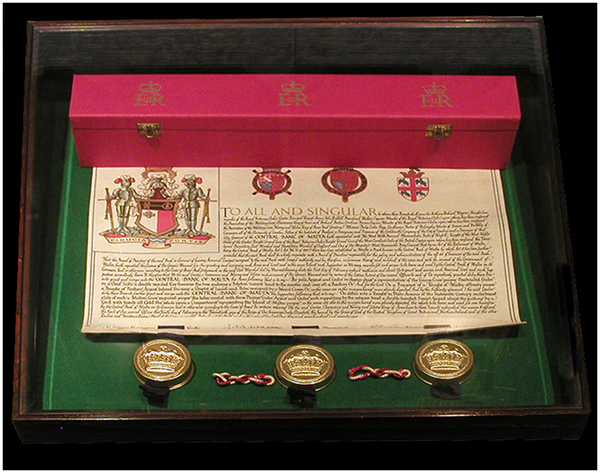Coat of arms

"FIDUCIA FORTIS 1968"
Heraldry is a system by which coats of arms and other armorial bearings are devised, described and regulated. It was primarily developed by the knights in mediaeval Christendom with the majority of symbols having their own technical terms, with French and Latin used principally in the description.
The establishment of the Armorial Bearings and Supporters of the Central Bank of Malta was a lengthy process involving registration in the official records of the College of Arms in the United Kingdom. By authority delegated to them by the Sovereign since the 15th century, three officers of the College, namely the Kings of Arms, grant arms in a document called Letters Patent.
The Armorial Bearings of the Bank were duly established by Letters Patent. In 1969, a formal application, known as a Memorial, was lodged with the Duke of Norfolk, the Earl Marshal at the College of Arms, through the Windsor Herald of Arms, acting on behalf of the Bank. This Memorial gave details of the Bank's constitution, its history and the law under which it was set up.
Once agreement on the design was reached, the Letters Patent was prepared on a large piece of vellum, or fine parchment, showing the Royal Arms, the Arms of the College of Arms, and those of the Earl Marshal. The text of the Patent was hand engrossed, and contains a formal description of the Bank's Arms. The document is officially signed and sealed by the King of Arms.
|
A preliminary sketch of the Armorial Bearings of the Bank was made by the well-known Maltese artist, Chevalier Emvin Cremona. The College suggested certain rearrangements to the original design and a final version was then sent to the United Kingdom. The artist sought to capture an element expressive of the Maltese spirit, namely, the mural crown surmounting the crest - symbolic of Malta's historic role as a fortress; the Maltese national colours, red and white, on the shield; the George Cross, awarded to Malta for bravery in April 1942 by King George VI and reproduced on the Bank's shield by authority of the Prime Minister of Malta; the dolphin on the head of the key, a fish known in classical Mediterranean literature and often appearing as a prime heraldic figure; and the laurel and palm branches, symbols of honour and peace, respectively, supporting the mural crown. The horizontal key on the shield is appropriate to the Armorial Bearings of the Bank, the governing financial institution in Malta and a key to economic progress and security. The design also contained, in Latin, the motto, "Fiducia Fortis" - "In Confidence Strength," and "1968", the date of the Bank's foundation.
|
 |
The two supporting Knights of Malta are a unique feature with very special significance. The granting of supporters to Armorial Bearings is a privilege allowed only to major institutions. The Knights represent confidence and strength, the two virtues incorporated in the Bank's motto. These symbolise some of the greatest pages in Malta's long military history, which, for more than two-and-a-half centuries, was ruled by the Order of the Knights of St John of Jerusalem. The plumed helmet of a knight which surmounts the shield also has a special connection to Malta as it was modelled on one found on a monument in the 16th century Co-Cathedral of St John in Valletta, built by the Knights.
The official copy of the Bank's Armorial Bearings contains colours reflecting Malta's historic past. The Knights on either side of the shield are of a steely blue colour. The feathers composing the plume on each helm on the Knights' heads are in red and white, while the blades, quillons and the pommel of the two-handed swords, together with the cords and tassels hanging from them are in gold, the same colour of the mural crown above the crest.
A black and white design of the Armorial Bearings was first used in the Bank's Annual Report for 1970. A library painting of the final version of the Armorial Bearings and Supporters was displayed at the official inauguration of the Bank on 13 February 1971. An embossed fibre-glass version in colour now hangs in the Bank's Board Room.

On euro adoption on 1 January 2008, the Central Bank of Malta became a member of the Eurosystem. To mark this event, the Central Bank of Malta adopted a new logo incorporating the term “Eurosystem” in Maltese. This is established practice at all euro area national central banks which, together with the European Central Bank, form the Eurosystem.
The logo displays the Bank’s coat of arms alongside the term “Central Bank of Malta” in English and Maltese, as displayed above. The two versions are separated by the term “Eurosistema”.